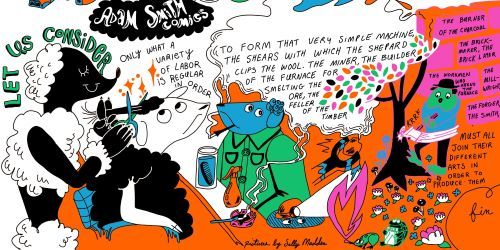Adam Smith Comics: The Woolen Coat

Before Leonard Read's "I, Pencil", before Russ Robert's "It's a Wonderful Loaf", there was Adam Smith's red woolen coat keeping laborers warm and reminding readers of the infinite, complicated stories behind even seemingly simple things.
Artist Sally Madden returns with a colorful cast of characters to show you how even a homely coat (sorry, coat!) is a wonder.
Observe the accommodation of the most common artificer or day-labourer in a civilized and thriving country, and you will perceive that the number of people of whose industry a part, though but a small part, has been employed in procuring him this accommodation, exceeds all computation. The woollen coat, for example, which covers the day-labourer, as coarse and rough as it may appear, is the produce of the joint labour of a great multitude of workmen. The shepherd, the sorter of the wool, the wool-comber or carder, the dyer, the scribbler, the spinner, the weaver, the fuller, the dresser, with many others, must all join their different arts in order to complete even this homely production. How many merchants and carriers, besides, must have been employed in transporting the materials from some of those workmen to others who often live in a very distant part of the country! how much commerce and navigation in particular, how many ship-builders, sailors, sail-makers, rope-makers, must have been employed in order to bring together the different drugs made use of by the dyer, which often come from the remotest corners of the world! What a variety of labour too is necessary in order to produce the tools of the meanest of those workmen! To say nothing of such complicated machines as the ship of the sailor, the mill of the fuller, or even the loom of the weaver, let us consider only what a variety of labour is requisite in order to form that very simple machine, the shears with which the shepherd clips the wool. The miner, the builder of the furnace for smelting the ore, the feller of the timber, the burner of the charcoal to be made use of in the smelting-house, the brick-maker, the brick-layer, the workmen who attend the furnace, the mill-wright, the forger, the smith, must all of them join their different arts in order to produce them. Were we to examine, in the same manner, all the different parts of his dress and household furniture, the coarse linen shirt which he wears next his skin, the shoes which cover his feet, the bed which he lies on, and all the different parts which compose it, the kitchen-grate at which he prepares his victuals, the coals which he makes use of for that purpose, dug from the bowels of the earth, and brought to him perhaps by a long sea and a long land carriage, all the other utensils of his kitchen, all the furniture of his table, the knives and forks, the earthen or pewter plates upon which he serves up and divides his victuals, the different hands employed in preparing his bread and his beer, the glass window which lets in the heat and the light, and keeps out the wind and the rain, with all the knowledge and art requisite for preparing that beautiful and happy invention, without which these northern parts of the world could scarce have afforded a very comfortable habitation, together with the tools of all the different workmen employed in producing those different conveniencies; if we examine, I say, all these things, and consider what a variety of labour is employed about each of them, we shall be sensible that without the assistance and co-operation of many thousands, the very meanest person in a civilized country could not be provided, even according to what we very falsely imagine, the easy and simple manner in which he is commonly accommodated. Compared, indeed, with the more extravagant luxury of the great, his accommodation must no doubt appear extremely simple and easy; and yet it may be true, perhaps, that the accommodation of an European prince does not always so much exceed that of an industrious and frugal peasant, as the accommodation of the latter exceeds that of many an African king, the absolute master of the lives and liberties of ten thousand naked savages.
(Adam Smith, An Inquiry into the Nature and Causes of the Wealth of Nations, Book I, Chapter 1: On the Division of Labor)
You can read the quotation in context here (just search for the word "coat".

Want More from Sally Madden?
Sally Madden's comics: "Not Only Loved But Lovely", "How The Theory of Moral Sentiments Begins" and "Not From Benevolence"
More words, less pictures
Adam Smith, An Inquiry into the Nature and Causes of the Wealth of Nations, Book I, Chapter 1: On the Division of Labor
Caren Oberg's “Who are you wearing?” Fashion production in the age of Adam Smith, AdamSmithWorks
Joy Buchanan's From Pins to Patterns: Following the Threads of Productivity, AdamSmithWorks
Virginia Postrel on Textiles and the Fabric of Civilization, EconTalk (See Amy Willis' Extra and Sarah Skwire's review of Postrel's book)
Arnold Kling's Camping-Trip Economics vs. Woolen-Coat Economics, EconLib
Mike Munger on the Division of Labor (EconTalk) and Division of Labor, Part 1, Part 2, and Part 3 (AdamSmithWorks)
Dan Klein on Coordination and Cooperation, EconTalk
Erik W. Matson's Adam Smith on Capitalism and the Common Good, EconLib